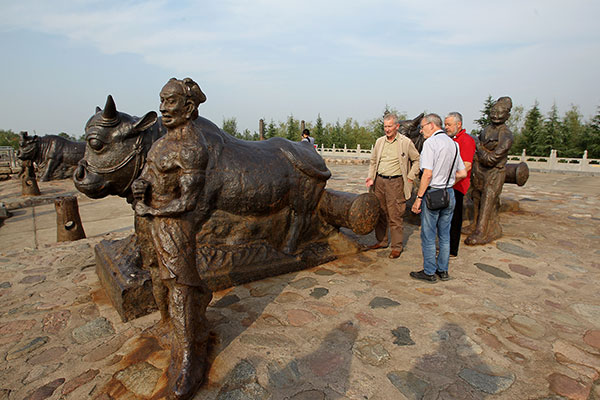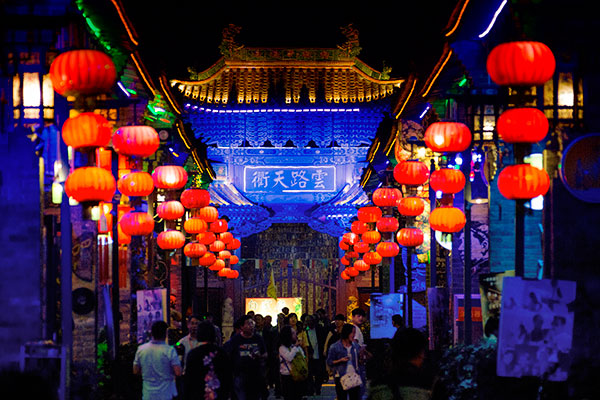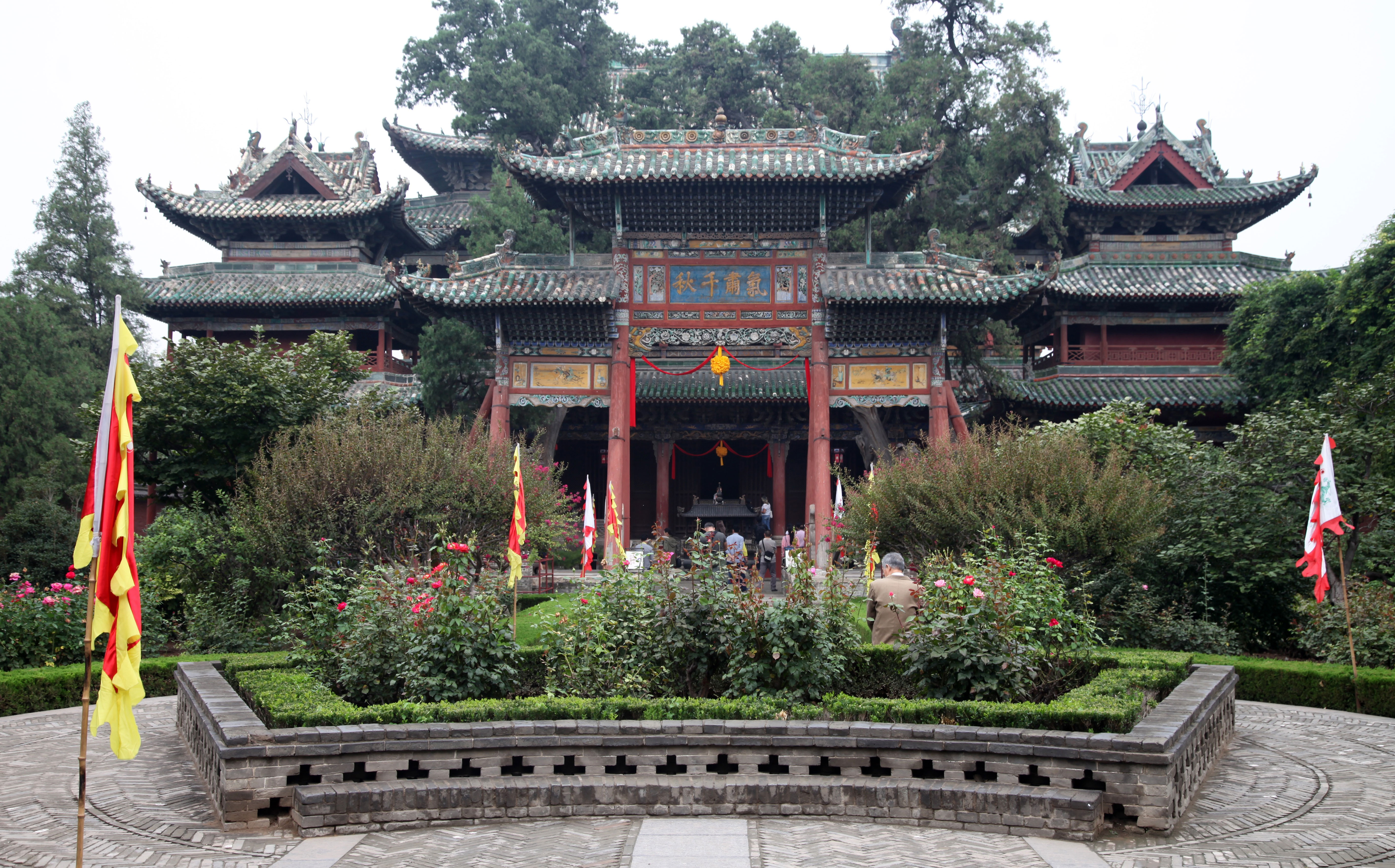600-229.jpg)
The sun sets over the South Gate of Pingyao old town.[Photo by Khalid Sharif/China Daily]
There was a light drizzle falling the morning we visited the Old Town of Pingyao, making the stone paving and more than 600-year-old city walls slick and softening the outlines of rooftops and well-preserved residences in a misty glimmer.
Our group-16 foreign writers, bloggers and photographers accompanied by China Daily staff and camera crew-were on the second day of a five-day cultural tour of Shanxi province, sponsored by the media outlet and the Shanxi Tourism Bureau.
Titled “Shanxi in the Eyes of Foreigners”, the visit could as easily have been named “Foreigners in the eyes of Shanxi”, as everywhere we went Chinese tourists and residents were eager to have their photos taken with a laowai.
600-222.jpg)
Foreign group members pose on a city tower in Pingyao as a drone films from above. [Photo by Zhang Wei/China Daily]
We were just as eager to photograph them-a 97-year-old man with straggly wisps of beard who smiled at us serenely as he sat in his doorway watching the tourists pass by, a snaggle-toothed man in his 80s whose lined skin and gnarled hands spoke of a life of labor, a grinning electric bus driver with long gray braids and dancing eyes who laughed as one of our photographers professed his love for her.
We had arrived in Taiyuan, the capital of Shanxi province, the previous day, some taking the high-speed train from Beijing or Xi’an, in neighboring and better-known Shaanxi province, others flying in from abroad, including from London, England.
The majority of us boarded a bus at the railway station that would become our most permanent home for the next five days, as our itinerary had us changing hotels four times in that time.
As an editor at China Daily, I had worked on stories from two previous trips to Shanxi this year and asked to attend the next, impressed by the stories and photos from previous participants. I was initially disappointed to see our itinerary, as I had been hoping to visit the Hanging Monastery and the Yungang Grottoes, two of the province’s best-known tourist sites.

Iron oxen were used as mooring posts for the Pujin Bridge in Yongji. [Photo by Zhang Wei/China Daily]
I was happy to see Pingyao’s Ancient City included, as the town built during the Ming (1368-1644) and Qing (1644-1911) dynasties is a still thriving residential and business area. We returned to the old town after lunch, when the rain had stopped, to visit the Pingyao International Photography Festival Exhibition and tour the former government buildings. For a journalist unaccustomed to “being” the story, it felt surreal as photographers took photos of other photographers looking at photographs, while we were also filmed for a documentary, snapped by local visitors and had aerial video shot of us by a drone-mounted camera.
At certain stops during our visit, particularly at tranquil temples or quiet courtyards, the loud buzzing of the drone broke the peace and many jokes were made about needing a giant fly swat, but the video it achieved was spectacular, particularly of the Hukou Waterfall in Linfen.

Visitors stroll at night in Pingyao’s old town. [Photo by Harri Jarvelainen/China Daily]
The largest waterfall on the Yellow River, and the second-largest in China, was impressive enough when seen from its edges, but the aerial views showed its full power. The drone also attracted its own admirers, with many Chinese stopping to photograph it in flight and on retrieval.
The city of Linfen, once known for the dubious honor of being one of the most polluted cities in the world, has shaken off that title as it looks to move from its traditional coal industry to focus on tourism. The Fen River runs through the downtown area, where we stayed, and our hosts took us on a spontaneous drive through Fen River Park and a short river cruise one evening. The river, which used to be full of garbage, has been rejuvenated and the park is filled with pleasant public areas. By night, the bridges and many of the buildings are illuminated, making for stunning photo opportunities.
The caliber of the photographers on the trip was superb, and I have been amazed as my WeChat account buzzes constantly to show me thumbprints of their shots as they edit and upload them.

Guandi Temple in Xiezhou county is dedicated to General Guan Yu. [Photo by Reinhard Klette/China Daily]
In Linfen, a city that covers 20,275 square kilometers and has a population of almost 5 million people, we also visited the Taosi relics site that is believed to be the origin of China’s civilization, dating back about 4,500 years to the time of Emperor Yao. Excavation began in the area in 1978 and more than 1,000 tombs have been discovered. The site also has the reconstruction of 13 pillars that, when you stand at a certain point to observe the sunrise, mark off the seasons of the Chinese year. It took two years of research for the archaeologists and scientists to discover the purpose of the pillars and discover the remains of the central point.
The results of another archaeological dig were a favorite of mine-four large iron oxen and their handlers that were smelted and cast during the Tang Dynasty (AD 618-907). The four are one of two groups used as mooring posts for the Pujin Bridge in Yongji-a major crossing point in ancient times. Each iron ox measures 1.9 meters high, 3 meters long and is 1.3 meters wide, and includes a three-meter pole set at an angle on the base to anchor the oxen more firmly as the river pulled on the floating bridge.
600-226.jpg)
Li’s Family Courtyard is known for its mix of architectural styles. [Photo by Khalid Sharif/China Daily]
A museum beneath the site, which is where the oxen were discovered, features a video about the discovery (in Chinese only) and photos of them being excavated. Viewers can’t help but imagine the excitement of those who discovered and uncovered the solid iron mooring posts, which show the sophisticated iron casting in the city at such an early time.
Our busy trip also included a visit to Guandi Temple in Xiezhou county and Yuncheng, which stands in reverence of Guan Yu, a famous general during the Three Kingdoms Period (AD 220-280). Our final day, which dawned crisp and clear, saw us visit Li’s Grand Courtyard, founded by wealthy yet altruistic businessman Li Ziyong.
600.jpg)
Pingyao old town is a vibrant community. [Photo by Harri Jarvelainen/China Daily]
The courtyard is known for its mix of architectural styles, including Chinese, Japanese and Gothic touches, and was the location for the CCTV drama Li’s Family Courtyard.
Harvey Morris, a freelance writer from the United Kingdom who took part in the trip, said the tourist industry in Shanxi province has much room to grow but would appeal to those who like to be ahead of trends and discover treasures off the beaten path.
From the delicious meals we ate, always featuring the noodles the province is known for, to the streets of its still thriving ancient city in Pingyao and the tranquil surrounds of the river park in Linfen, the province has much to offer visitors wishing to learn more of China’s traditions and culture.
